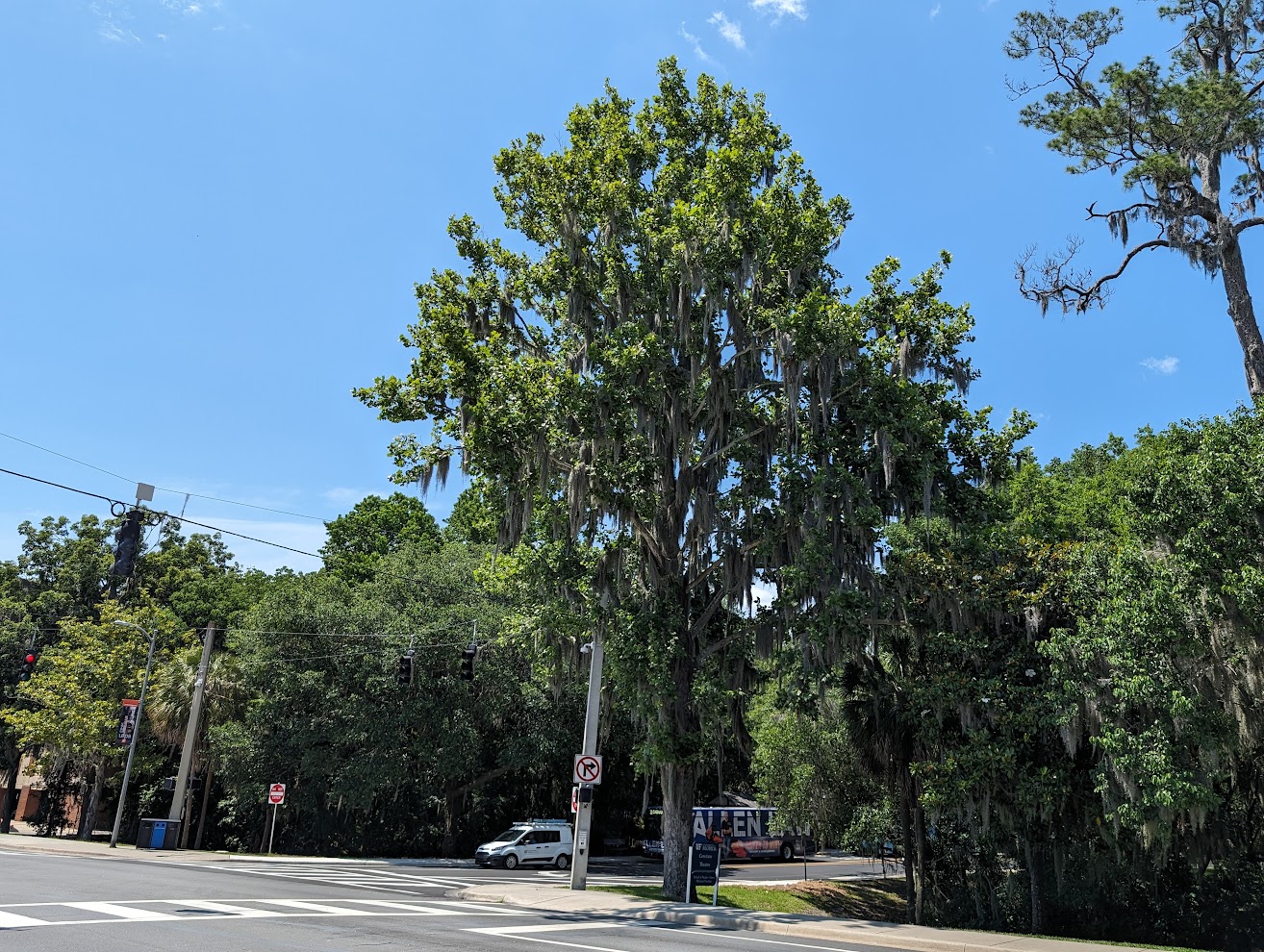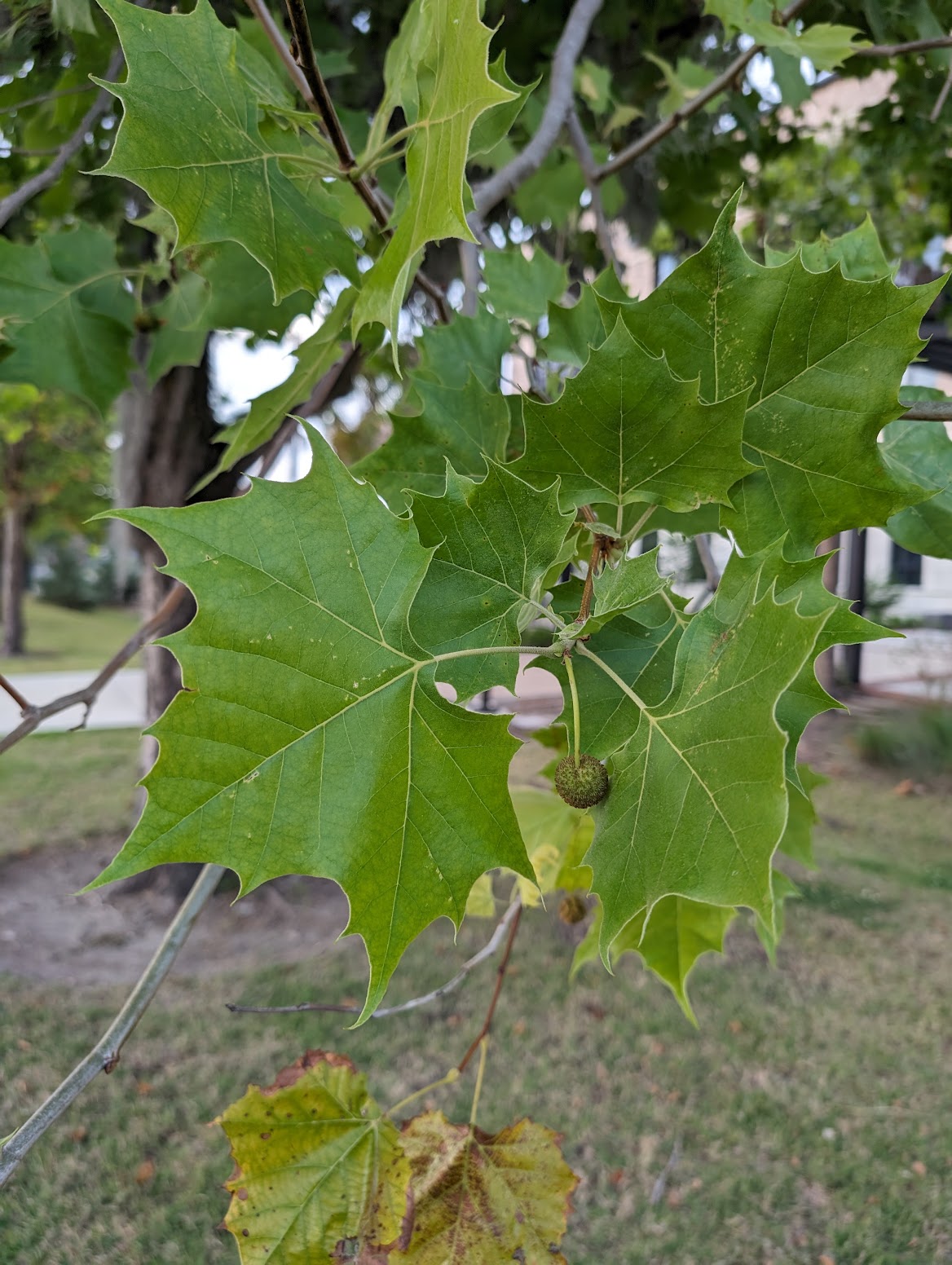Platanaceae – Sycamore Family
In 2024, this American sycamore measured 84 feet tall and had a diameter of 30 inches. Based on USDA Forest Service models, it will absorb approximately 3,198 lbs. of carbon over the next 20 years. Put simply, this tree will offset up to 12,940 car miles worth of carbon dioxide.
See all species on our Campus Tree Tour.
Introduction
American sycamore is a prominent tree known throughout the Eastern United States for its unique bark, dense canopy, and large leaves. This sycamore is recognized as a “Moon Tree.” As a seed, the tree was taken to the moon by Stuart Roosa, an astronaut aboard the Apollo 14 in 1971, along with a total of 2,000 other seeds. Upon their return, the seeds were distributed to important American landmarks along with other countries, including Brazil and Switzerland. The sycamore in front of you was planted in 1977, memorializing Stuart Roosa and one of America’s first visits to the moon.
Physical Description
Life expectancy: 50 to over 200 years
Height: 75 – 90 feet
Crown: 50 – 70 feet
Diameter: Up to 120 inches
Bark: Exfoliating plates that peel off to reveal a creamy white, green, and tan trunk that browns as it matures. Looks like desert camouflage.
Leaves: Deciduous, simple, and alternately arranged upon the stem. Leaves are lobed and large with toothed margins. They are greenish yellow and pubescent (hairy) on upper and lower surfaces of the leaves that rub off over time.
Twigs: Green and thin with pubescence and occasional stipules where the leaf connects to the twig.
Flowers: Small red flowers that bloom in dense clusters during spring.
Fruits: Round green fruit ½ to 1 inch in size that turns brown and releases individual air-borne seeds as it ripens during fall and winter.
Key Identification Characteristics: camouflage patterned bark, large leaves, alternate arrangement.
Past and Present Uses
Indigenous tribes used the American sycamore for medicinal purposes, such as cold remedies and other aids. In the 1960’s and 1970’s, the American sycamore was planted in southeastern plantations for timber. The tree produced valuable hardwood timber used for furniture, interior trim, boxes, pulpwood, and fuelwood.
Currently, the American sycamore is used for its timber in the north, and it is often planted in urban landscaping due to its fast growth rate. The tree is also planted in rehabilitation sites since it grows well in disturbed areas.
Ecological Importance
Origin: Native to the United States
Native Range: Found throughout the Eastern United States (Figure 1).

Figure 1. Native range of American Sycamore. Photo credit: U.S. Geological Survey
The American sycamore is commonly found in riparian zones in moist soils along stream banks, edges of swamps, and flood plain areas. It grows well in disturbed areas with limited drought and fire. The sycamore is also a pioneer species in old, eroded field sites. Within its southern range, the tree is seen with green ash, sugarberry, eastern cottonwood, sweetgum, and river birch.
American sycamore seeds provide food for various songbirds such as the purple finch, goldfinch, chickadees, and the dark-eye junco as well as mammals such as muskrats, beavers, and squirrels. The sycamore also provides valuable shelter; with age, its trucks become hollow enough for cavity nesting birds and occasionally black bears to live in.
More Information
https://edis.ifas.ufl.edu/publication/ST484
References
i-Tree. (2006). Tree tools - calculate the benefits of trees!. i-Tree. https://www.itreetools.org/
Nesom, G. (n.d.). American sycamore - USDA plants database. Plant Guide. USDA, NRCS. https://plants.usda.gov/DocumentLibrary/plantguide/pdf/cs_ploc.pdf
Sullivan, J. (1994). Platanus occidentalis. In: Fire Effects Information System, [Online]. U.S. Department of Agriculture, Forest Service, Rocky Mountain Research Station, Fire Sciences Laboratory. https://www.fs.usda.gov/database/feis/plants/tree/plaocc/all.html
Wells, O. O., & Schmidtling, R. C. (n.d.). Sycamore. Platanus occidentalis L. U.S. Department of Agriculture, Forest Service. https://www.srs.fs.usda.gov/pubs/misc/ag_654/volume_2/platanus/occidentalis.htm#:~:text=Platanus%20occidentalis%20L&text=Sycamore%20(Platanus%20occidentalis)%20is%20a,of%20lowlands%20and%20old%20fields
Williams, D. R. (n.d.). The Moon Trees. NASA. https://nssdc.gsfc.nasa.gov/planetary/lunar/moon_tree.html



